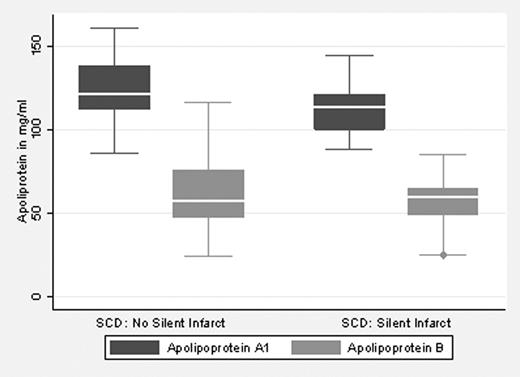Abstract
Abstract 259
Cerebral infarct is a frequent complication in children and adults with sickle cell disease (SCD). About 10% of children with sickle cell anemia (HbSS) will have an overt stroke by 18 years of age and another 22% will have “silent” cerebral infarcts by 14 years of age. There is a second peak in the incidence of overt ischemic stroke in adults with SCD. Both silent and overt stroke can be accompanied by cognitive impairment and thereby increased risk of academic failure. Several laboratory parameters have been associated with these complications, including low hematocrit or hemoglobin, high white blood cell count (WBC), and high platelet count, while lactate dehydrogenase (LDH) and apolipoprotein A1 have been associated with pulmonary vasculopathy in adults with SCD. Elevated C-reactive protein (CRP) and the ratio of apolipoprotein B/A1 are associated with increased stroke risk in the general population. We hypothesized that these and other biomarkers might also be important in children with silent cerebral infarction.
We prospectively measured potential biomarkers, including complete blood count, reticulocytes, fetal hemoglobin (HbF), LDH, CRP, and apolipoprotein A1 and B in 73 children with HbSS and 3 with sickle-β0-thalassemia (HbSβ0), in addition to performing brain magnetic resonance imaging (MRI), in a single center ancillary study of the Silent Infarct Transfusion Trial. MRIs were interpreted for the presence or absence of silent cerebral infarcts (FLAIR hyperintensities ≥3 mm in diameter seen in at least two imaging planes without corresponding symptoms or signs of stroke). Groups were compared by Student's t-test or Wilcoxon rank-sum test and associations evaluated by univariate and multivariate logistic regression.
Twenty-seven participants (35.5%, 1 with HbSβ0) had silent cerebral infarcts (age 8.9 ± 2.4 years, 59% male) and 49 (65.2%) had normal brain MRIs (age 8.7 ± 2.1, 53% male). The group with SCD and silent cerebral infarcts had significantly lower hemoglobin concentration and apolipoprotein A1 (P=0.01 for both) than children with SCD without silent cerebral infarcts. Apolipoprotein B and the ratio of apolipoprotein B to A1 were similar between groups. By univariate logistic regression, both apolipoprotein A1 [Odds ratio (OR) 0.95 per mg/dl increase, P<0.05] and hemoglobin (OR 0.52 per g/L increase, P<0.05) were associated with silent cerebral infarct; however, in a multivariate model, apolipoprotein A1 (OR 0.96 per mg/dl, P<0.05), but not hemoglobin (OR 0.78 per g/L, P=0.5), was significantly associated with silent cerebral infarct.
These data suggest a role of apolipoprotein A1 in the pathogenesis of silent cerebral infarct in children with SCD. Apolipoprotein A1 is a plausible marker or risk factor for cerebrovascular disease in SCD, given the association of lower levels with pulmonary hypertension in SCD and increased risk for cererbrovascular and cardiac disease in the general population. This marker should be studied in a larger longitudinal cohort of children at risk for cerebral infarcts.
Potential Biomarkers by Group [Mean ± Standard Deviation Compared by T-Test or Median (IQR) by Rank-Sum Test]
| Marker . | SCD: Infarct . | SCD: No Infarct . | P-Value . |
|---|---|---|---|
| Hemoglobin (g/dl) | 7.7±1.0 | 8.3±1.0 | 0.01 |
| Hemoglobin F (%) | 8.4 (5.5, 11.5) | 10.6 (5.1, 16.5) | 0.18 |
| WBC (per ul) | 12,514±3469 | 12,076±3599 | 0.60 |
| Reticulocytes (%) | 12.6±6.5 | 11.6±4.8 | 0.46 |
| CRP (mg/L) | 2.2 (1.6, 5) | 2 (1.2, 4.3) | 0.5 |
| Apo A1 (mg/dl) | 114±16 | 124±19 | 0.01 |
| Apo B (mg/dl) | 57±15 | 60±20 | 0.72 |
| Apo B/Apo A1 | 0.50±0.13 | 0.49±0.18 | 0.49 |
| LDH (U/L) | 573±140 | 631±178 | 0.21 |
| Marker . | SCD: Infarct . | SCD: No Infarct . | P-Value . |
|---|---|---|---|
| Hemoglobin (g/dl) | 7.7±1.0 | 8.3±1.0 | 0.01 |
| Hemoglobin F (%) | 8.4 (5.5, 11.5) | 10.6 (5.1, 16.5) | 0.18 |
| WBC (per ul) | 12,514±3469 | 12,076±3599 | 0.60 |
| Reticulocytes (%) | 12.6±6.5 | 11.6±4.8 | 0.46 |
| CRP (mg/L) | 2.2 (1.6, 5) | 2 (1.2, 4.3) | 0.5 |
| Apo A1 (mg/dl) | 114±16 | 124±19 | 0.01 |
| Apo B (mg/dl) | 57±15 | 60±20 | 0.72 |
| Apo B/Apo A1 | 0.50±0.13 | 0.49±0.18 | 0.49 |
| LDH (U/L) | 573±140 | 631±178 | 0.21 |
Apo indicates apolipoprotein
Strouse:General Electric: Equity Ownership. Casella:Boehringer Ingelheim: Honoraria; Cytrex: Research Funding; Ikaria: Research Funding.
Author notes
Asterisk with author names denotes non-ASH members.


This feature is available to Subscribers Only
Sign In or Create an Account Close Modal